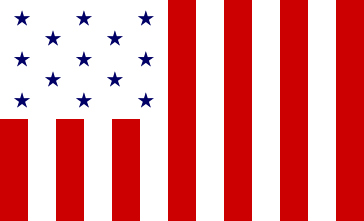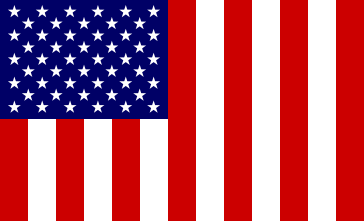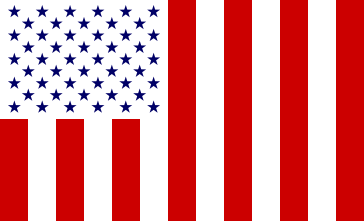 image by Tomislav Todorovic
image by Tomislav Todorovic[Speculative, based on "civil" flag description in Hawthorn's story.]

Last modified: 2015-03-28 by rick wyatt
Keywords: united states | flag urban legend | urban legend | bullet | civilian flag | civil flag |
Links: FOTW homepage |
search |
disclaimer and copyright |
write us |
mirrors
See also:
 image by Tomislav Todorovic
image by Tomislav Todorovic
[Speculative, based on "civil" flag description in Hawthorn's story.]
Nathaniel Hawthorn´s "The Scarlet Letter" contains a description of an American Customs flag erroneously described as having 13 stripes, when in fact it has 16. One stripe for each state at the time the flag was introduced. Remember, this was before limiting the stripes to 13. The story also states that this indicated a civil operation rather than military. This statement is somewhat true, but not totally accurate. Yes, customs is a civil authority, but this does not mean that all civil authorities use this flag. Also let us not forget that The Scarlet Letter is a work of fiction and not a research document by any means and therefore should not be used as a primary source. Primary sources would include legislation and executive orders, these are non-existent for the flag described at this site. United States flag legislation has been thoroughly researched by vexillologists and I think it would be safe to say that there is no legislation or executive order for the flag described.
Another erroneous source goes on to say that the Civilian flag should have blue stars on white, not vice versa, and shows the stars arranged in a pattern identical to the current 50 star American flag established in 1960. If the civil flag has been out of use since the 1860s, as he claims, then, lacking enabling legislation, the pattern should have been stopped at 33 or 35 stars. it is also stated that prior to World War II, states only flew their own flags. This is simply not true. If the states were as sovereign as he is trying to indicate, state flags would have been in use since 1776. In truth, most states had no state flag until the late 19th century, 100 years after the Revolution.
In short, other than as a footnote of erroneous concepts and faulty research, the civil flag described has no place on the FOTW website.
Nathan Bliss, 28 July 1999
 Variant #A
Variant #A
 Variant #B
Variant #B
Suppositious flag images by Tomislav Todorovic
When Nathaniel Hawthorn wrote "The Scarlet Letter," a work of fiction, little did he realize that one of his passages would generate an urban legend about a non-existing "Civil" US flag in the 20th Century. It is simply amazing how one sentence can generate such a large amount of fiction about an imaginary flag.
The sentence read: "From the loftiest point of its roof, during precisely three and a half hours of each forenoon, floats or droops, in breeze or calm, the banner of the republic; but with the thirteen stripes turned vertically, instead of horizontally, and thus indicating that a civil, and not a military, post of Uncle Sam's government is here established."
Since then several speculative illustrations of this flag have come into existence, and more recently modern interpretative versions have seen use as protest or message flags. The Civil Flag has given us a perfect example of a mythical suppositious flag (formed from or growing out of supposition: suppositious evidence) becoming a reality. For example, supporters of Ron Paul have now flown a modern version (Variant #B) of the civil flag at Ron Paul presidential rallies (with 50 stars instead of the original 13), and it is presently being sold on the internet as the "US Civil Flag."
Examples of the spread of this urban legend can be found at "Barefoot Bobs," "Flag Code, Etiquette and Laws.", and "The Mystery of the Forgotten U.S. Flag Revealed" (pdf file - author unknown). These three sites all provide examples of merging fact with fiction to attempt to support the urban legend of a civil flag.
For a better explanation about how urban myths in the flag world start, read my essay at "The Urban Legend of a 'Civilian' National Flag."
Pete Loeser, 14 November 2014
Don't forget to always add the fact that the flag itself was real and existed for most of the 19th century. It was the US Customs Ensign and Signal, which is what Hawthorne certainly meant when he described the building in a passage before the quote you give, because it is stated he was working in the "Customs House." The sentence is often removed from the description of the building thus separating the reason for the flag from the actual flag itself, making the myth more believable and harder to track down. I know the sources you cite go into this, but you should always reiterate it whenever you are referring to this legend. In addition, the original flag Hawthorne was describing had a blue eagle in a white canton with an arc of 13 stars. That should be the "original" flag, not some speculative design that never existed.
Dave Martucci, 15 November 2014
There are some myths about ornaments used at the head of a flag pole. Some crazies started a myth in the 1950s that the round ball commonly found on the head of outdoor flag poles in the United States contained a razor, lighter, or flare to be used in the event of a Soviet takeover to destroy the flag. This is, of course, sheer fantasy. The balls were in use long before there was a Cold War. Besides that, getting at the ball would have required considerable effort.
Another myth is that the flat headed finials were designed to provide landing guidance for alien space vehicles. The fact that those caps had been used long before alien vehicles were contemplated is explained away by saying that individual aliens were commonly sent ahead of the main wave by several generations so that humans wouldn't think any thing unusual about flat headed flag poles.
Phil Abbey, 7 October 1998
One myth, apparently created during the Cold War, is that the ball at the top of U.S. flagpoles contains three items, all intended to keep the communists from capturing the flag. These are most commonly said to be a razor blade (to cut the flag from the halyards), a match (to light it), and a bullet (to shoot the attackers).
Although this is absurd on the face of it, there seems to be no end to the line of morons who believe it. I'm not calling anyone else who questions this myth a moron - they're to be applauded for having the good sense to question it. It's those who believe it without questioning it that need to be put away. So the following points are intended for use by those who are confronted with this idiocy in answering the true believers:
That should be enough. I suspect that this question originated as one of those gag bits of phony trivia used in military academies and basic training to hassle new cadets and recruits, like sending a seaman recruit to the engine room to fetch a bucket of steam. The problem is that this particular joke had too much goofy political resonance for the gullible to realize it was a hoax.
- There have been balls on flagpoles for centuries, long before there were communists or, for that matter, self-contained bullets or friction matches. They're there because someone discovered that flagpoles look better with a ball on top. (No, not to keep birds from perching - birds have no trouble at all perching on the ball on a flagpole.)
- If you want to destroy the flag, why not just lower it by the halyards the normal way and use materials readily available on the ground to destroy it, or better yet take it with you? As opposed to trying to cut it apart and burn it while hanging from the top of the pole like a monkey.
- OK, so you don't want to lower the flag because that would signify surrender. How on earth would you retrieve what's in the ball in the face of an enemy assault? Assuming you don't have a ladder (if you do, why can't you find some matches?), there are only two ways up - climb the pole or have oneself hoisted up on the halyard. Maybe a professional acrobat could do the former, given time; we're talking about shinnying up a smooth metal pole or pulling yourself up a narrow rope 50 feet (15 meters) or higher, all with enemy troops shooting at you.
- Let's suppose you're going up by being hoisted on the halyard. As you do that, the flag comes down - whoops, you've just surrendered. Anyway, the flag is now at ground level, so your friends can detach it using the clips and escape with it or destroy it as described above. You don't have any friends on the ground? Then how did you get to the top of the pole? Just try pulling yourself up a flagpole some time and see how easy that is.
- Why the bullet? Are your friends on the ground just standing around watching, or are they fighting back? Oh, right, you're all alone and you're a world-class gymnast who can just climb up the pole or halyard 50 feet or more under fire. OK, well then, if you have a gun with you (that coincidentally is of the right caliber for the bullet), why didn't you load it before you started up? And a single bullet to deal with the Red hordes, fired accurately while clutching for dear life to the top of a pole with no obvious hand holds, all while trying to hang on to a burning flag so that it can't fall and be captured?
The eagle on the official U.S. Coat-of-Arms and seal has always faced dexter, toward the olive branch. Some 19th century military colors had the arrows in the dexter claw or the eagle's head facing sinister, but this was not normal, nor was it ever the case on the great seal, nor did it ever have anything to do with wartime vs. peacetime.
The Presidential coat-of-arms (the U.S. COA as depicted on the Presidential seal) formerly had the eagle facing sinister, toward the arrows. This design was incorporated into the 1916 Presidential flag. The direction of the head was reversed when the flag was redesigned in 1945, as much to have the eagle facing the honorable dexter direction as to have it looking toward the olive branches.
Joe McMillan, 5 February 2001
This seems to be referring to the hypothesis promoted by Boleslaw and Marie-Louise Mastai (IIRC) that variations of the stars & stripes which have the canton resting on a red stripe were intended for use during periods of war. The
reasoning behind this apparently being the red stripe represented bloodshed. I don't think many other vexillologists, if any, accept this hypothesis.
Ned Smith, 13 September 2007
Interestingly enough, this particular legend may have just a sliver of truth behind it. The following is a quote from Preble (1880) pp. 468-69:
". . . in 1835 . . . flags with the union resting on the red stripe were made at the Norfolk Navy Yard for all the vessels of war equipped at that station, and for many years thereafter. They were called by the quartermasters "Norfolk war-flags," because the union rested on a red or war stripe. . . .
"The commercial code of signals published yearly in London . . . has since 1859 and up to the present time, committed the same error. In the colored plate of the ensigns worn by merchant vessels of different nations . . . the United States ensign is represented with three red and three white stripes joining the vertical edges of the union, and the union resting on the fourth red stripe, instead of being made to rest on the fourth white stripe, - a singular error in a work of such high official standing."
Preble was himself a naval officer who served in the Civil War, so this particular bit of information might well have been based on first-hand knowledge. It sounds as if the flags with the union on the red stripe were not deliberately manufactured as "war flags," but came to be called that after the fact.
Preble also notes that between 1794 and 1818, when the flag had 15 stripes, the union "invariably" rested on the ninth stripe, which was red.
Peter Ansoff, 13 September 2007
In response to the "invisible flag of death" query about the invisible flag of death flying over the national standard when the national standard was at 1/2 mast or 1/2 staff (depending on your terminology).
The earliest known case of half-masting a flag to indicate mourning was in the English merchant navy in 1612, but the report of that incident makes clear that it was already in use before then. It seems clear that allowing the ensign to droop in a sloppy manner was part of the general practice of giving the ship a slovenly appearance when it was in mourning. This is consistent with the practice of doing the same with one's personal appearance--think of the Jewish custom of rending the garment - under the same circumstances. See Flags at half Mast for a very complete discussion.
I'm sure that someone at some point made the poetic observation that half-staffing left room for the "invisible flag of death," but that doesn't make it an accurate account of the basis of the custom. In any case, it is clearly merely metaphorical and thus irrelevant to the issue of what real flags may or may not be flown higher than or directly above the U.S. flag
The "invisible flag of death" thing is totally a myth.
Joseph McMillan, 7 April 2012
States are represented collectively; there is no meaning to particular stars nor stripes. That a particular star or stripe refers to a specific state is a complete myth. To me, the fact that no star "stands" for any particular state, but they stand as a whole with none predominating, is one of the positive points about the flag. (For that matter, not even the colors stand for anything.)
Nathan Lamm, 5 February 2007
A prevalent rumor is that the reason why Morning Colors is at 0800 is because of the attack on Pearl Harbor.
Pearl Harbor was attacked at 0800 as morning colors were being conducted. (The band aboard USS Nevada gained everlasting glory among Navy musicians for completing the playing of the national anthem before scattering to take battle stations.) This should be a clue that the custom of conducting morning colors at 0800 existed prior to the attack. In fact, Navy Regulations have stipulated 0800 as the time for morning colors ever since 1870.
Before that, the time for colors depended on the time of local sunset--yes, that's right, not sunrise, but sunset. If sunset was before 1800 (6 p.m.), then colors were at 0800; if sunset was after 6 p.m., colors were at 0900.
So no, morning colors are not at 0800 because of the timing of the attack.
Joe McMillan, 15 March 2009